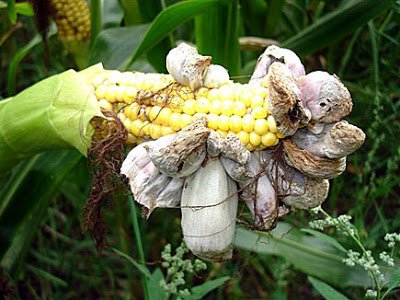Corn smut Cuitlacoche (Kweet-lah-ko-chay) or Huitlacoche is a black fungus that infects corn fields. This fungus makes the kernel bulbous and swollen as they get filled with spores.
A silver grey spore mass, black on the inside when ripe, cuitlacoche is a soil-borne organism that grows on the corn kernels themselves and is known as usilago maydis botanically.
Cuitlacoche is actually a bulbous fungus that attacks the ears of corn and makes the kernel swell to 10 times the normal size. The corn’s color sometimes turns an ugly medium to dark grey verging on black.
This corn smut is smooth and dry to the touch, spongy in texture, and becomes a rich, black puree as it cooks.
Its taste has been compared to several European varieties of wild mushroom, and is often described as being earthy.
History of Cuitlacoche
The Aztec named this dark growth found on corn huitlacoche which translates to raven’s excreta. American farmers call it smut and devil’s corn. They consider it as a disease to be irradiated.
Corn Smut Cuitlacoche also goes by some other names. It is frequently called maize mushroom , corn smut or Mexican truffles.
The Mexican and American Hopi Indians consider the fungus as delightful delicacy. The Aztecs listed Cuitlacoche as one of the six varieties of edible mushrooms.
The Maya too, used huitlacoche, boiled, roasted or cooked as tamales in corn husks.
The Zuni Indians call the corn fungus corn soot and says it symbolizes the generation of life. The French call it goitre du mais.
Today, in Mexico the product is actually cultivated each season providing an ample supply to be eaten fresh, then frozen and canned.
One pound of canned Cuitlacoche is sold at US$30 – 40.
Cuitlacoche Recipe in Restaurants
Mexican restaurants have a wide range of menu which includes corn smut Cuitlacoche appetizers, soup, crepes, tortilla torte and even a Cuitlacoche ice creams.
Food lovers say that Cuitlacoche has a smoky sweet flavor that is a cross between that of a corn and mushroom.
Corn smut Cuitlacoche goes best with the foods that are at the height of their season at the same time. It can be used in place of, or addition to, many types of mushroom.
A single can of Cuitlacoche is equal to the amount found on four ears of corn, or approximately one pound of fresh corn smut.
It is sensational in crepes and egg dishes. Corn smut Cuitlacoche also makes a great cream soup and is a natural with poblano chillies.
Cuitlacoche in USA market
Cuitlacoche is currently being cultivated in limited quantities in several US cities like California, Florida, Georgia and Virginia. It is sold canned and frozen in some gourmet markets.
This edible corn smut Cuitlacoche is found in specialty produce and farmers’ market during corn season.
In US, Cuitlacoche is used in a variety of dishes including sautes, soups, casseroles and any preparations where cooked mushrooms would be added.
Now, Cuitlacoche are found easily in supermarkets and Latin groceries, canned under the brand name Herdez.
Health Benefit of Corn Smut Cuitlacoche
Chuitlacoche is a rich source of protein, lysine and unsaturated fatty acids.
Since Lysine is an amino acid which promotes healthier and stronger bones and boosts our immune system of our body. Beta-glucans are found in this fungus whicha are helpful in reducing in cholesterol.
Our body requires Lysine but can not manufacture itself. We need it to fight infections and strengthen bones. Bodybuilders pound Lysine when they want to build muscle, and beautician recommend it to keep skin looking young.
Cuitlacoche is so important and highly demand nowadays that researchers at University of Wisconsin convinced local farmers to deliberately infect their corn farm with the fungus, and then harvest and sell it.
A corn will sell in less than a dime but Corn smut Cuitlacoche will sell in dollars.
So, it is safe to eat Corn Smut Cuitlacoche!

Naorem Mohen is a natural farmer, full-time blogger, and entrepreneur dedicated to promoting Manipur’s black rice Chakhao, local beverages, and edible mushrooms.

Comments on “I believe you will love Corn Smut Cuitlacoche”
Comments are closed.